Optimized in vitro analysis of biological tissues
The design of our bucket allows for a simplified manipulation of the tissues in inmunohistochemical techniques.
In vitro analysis of tissues is a very common procedure in biological laboratories, for example, in immunohistochemical tests, in which plate wells are used. However, the handling of the tissue is often complex, both due to the fragility of the tissue and the small size of the wells. On the other hand, currently available buckets are not adequately optimized to allow for an efficient use of reactants or of the available surface of the grid.
This invention consists in a bucket that can be de disassembled and reassembled to allow for the substitution of the grid, being therefore highly adaptable. Furthermore, its design has been optimized to fit accurately into the wells to avoid leakages and guarantee a complete contact of the reactants with the tissue. The design also avoids the existence of irregular joints that may damage the tissue, so the total surface of the grid can be used safely. The size and dimensions of the bucket and its grid can be also adapted to fit every plate available in the market.
Main innovations and advantages
· Detachable bucket that allows an easy and quick substitution of the grid because of the mechanical union between parts.
· The absence of strong joints impedes the existence of irregular parts that may damage the tissue, allowing for a maximized use of the surface of the grid.
· Its design maximizes the contact surface between the walls of the bucket and the well, maximizing the surface of contact of the tissue and the reactant for an efficient use.
· Its manufacturing is simple and cheap, and does not require of specialized processes or materials, being therefore easy to escalate.
· Its main application is in biological laboratories, for in vitro tissue analysis, being of interest in any method that requires the use of plate wells.






